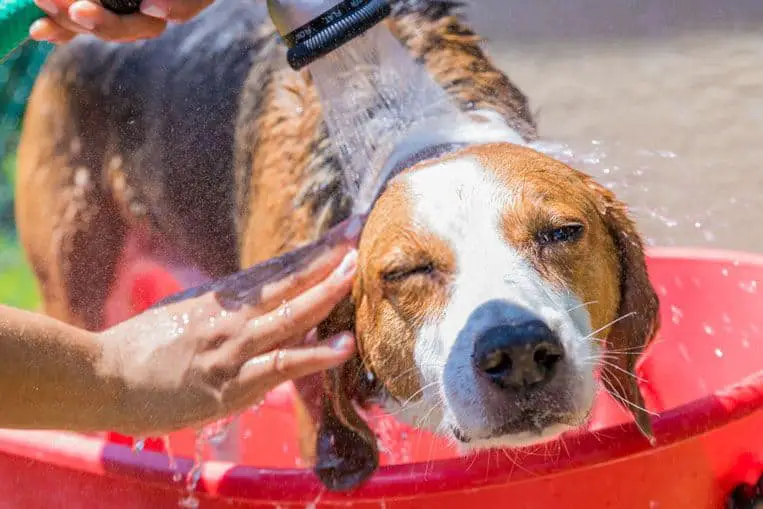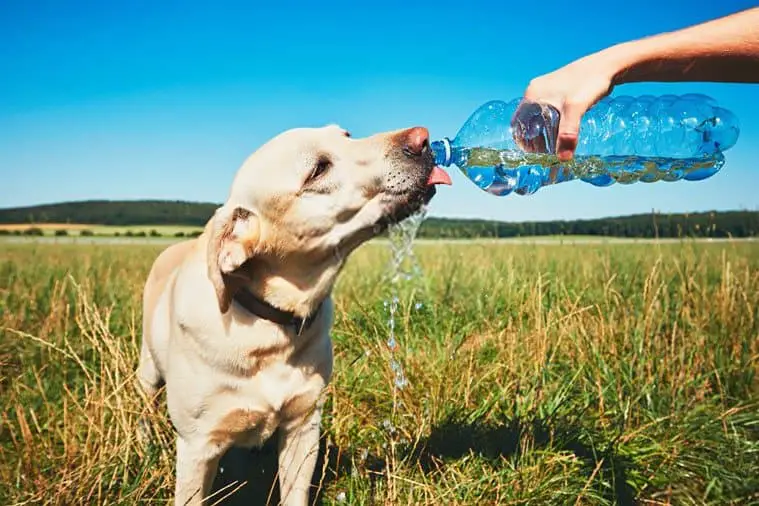Last Updated on 11/05/2020 by Veronica Jones
It might not be something on the forefront of your mind if you’re like me right now, wrapped in the middle of winter. But heat stroke in dogs is something that all dog parents should know about as it isn’t just an issue that occurs in the warmer months. Heat stroke in dogs can happen even when you’re having to scrape snow off of your car in the winter, so it’s important to know what can cause it, how to recognize it, as well as what you can do to treat it.
What is Heat Stroke in Dogs?

Heat stroke refers to hyperthermia, or a body temperature that exceeds 103℉. Heat stroke is especially an issue in dogs because they lack sufficient sweat glands to aid in cooling, and instead rely solely on panting as a way to dissipate heat. With heat stroke there is no previous symptoms to indicate that your dog may be running a fever, and body temperatures can exceed 106℉, whereas much higher than that and multiple organ failure starts to occur.
What Causes Heat Stroke in Dogs?
Heat stroke can happen due to two main causes: a high environmental temperature or overexertion. Either of these causes can happen in both warm and cold temperatures, so let’s break down the specific causes of heat stroke based on the season.
Hot weather
 The most common cause of heat stroke during hot weather is due to owner negligence. Leaving a dog in a vehicle with the windows up in the summer heat produces an oven-like effect that causes heat stroke in a very short time, sometimes even minutes. Dogs that are left outside on hot days without access to shade or water can also experience heat stroke. Exercising in the heat without a chance to rest and cool down may lead to heat stroke as well. Don’t forget about humidity. Just as your sweat fails to cool you as well on very humid days, panting suffers in the same way. Having a high humidity makes lower temperatures just as dangerous a very high ones.
The most common cause of heat stroke during hot weather is due to owner negligence. Leaving a dog in a vehicle with the windows up in the summer heat produces an oven-like effect that causes heat stroke in a very short time, sometimes even minutes. Dogs that are left outside on hot days without access to shade or water can also experience heat stroke. Exercising in the heat without a chance to rest and cool down may lead to heat stroke as well. Don’t forget about humidity. Just as your sweat fails to cool you as well on very humid days, panting suffers in the same way. Having a high humidity makes lower temperatures just as dangerous a very high ones.
Cold weather
Don’t underestimate the heating power of a wood stove, especially in a small, confined space. Dogs that are in close quarters to a wood stove or other heater can experience heat stroke if there isn’t proper ventilation. Strenuous exercise, even in cold weather, may lead to heat stroke, especially if that pup is carrying a heavy winter coat, natural fur or manmade. As dog parents, we often incorrectly assume that all dogs require winter wear, even when venturing out for only a short time. While it’s true that short-haired and smaller breeds definitely benefit from some additional layers, not all critters need a coat, no matter how cute they may look in them. Dogs that are too heavily bundled and that engage in a heated game of fetch can be at risk for heat stroke.
Any weather
There are a few causes of heat stroke that can happen in any weather. Most of these causes stem from medical roots, although a few can be human induced. Since panting is a dog’s main way of cooling themselves, any restriction to it is going to lead to problems. Brachycephalic dogs, or those with smushed faces like bulldogs and pugs, are at greater risk for heat stroke simply because there is restriction to their airways. If you’ve heard a pug or bulldog breathe, then you know what I’m talking about. This makes panting even less efficient, and these breeds may have trouble even with mild increases in environmental temperatures.
On that note of restriction to panting, any dog that is forced to wear a muzzle for an extended period of time may develop heat stroke. Especially if that dog is easily excited, exercising, or in a warm environment.
Infections that are severe enough to cause high fevers may also cause heat stroke, especially if these infections are in the lungs or airways. Fevers high enough to lead to heat stroke don’t go unnoticed as this poor dog will be very sick beforehand. I have even seen seizures lead to heat stroke in dogs. The amount of muscular activity that occurs during an extended seizure can be equivalent to sprinting miles in the hot sun. If the seizure doesn’t get under control, it can lead to an elevation in body temperature that is dangerous.
How to is Heat Stroke in Dogs Treated?
Your dog’s main way of cooling down in through panting. Panting cools by evaporating moisture from the nasal passages and mouth as the hot hair moves out of the body. It works similar to sweating, but instead of providing quick, whole body relief, the cooled area is more targeted. From this you can see that panting isn’t the most efficient means of cooling off, especially when body temperatures get really high. So, in cases of heat stroke, dogs need your help to cool them down.

This doesn’t mean dunking your dog in a tub of ice water. The process to cool down a dog with heat stroke should be gradual and controlled to prevent additional complications, such as shock. Seek a veterinarian’s help as soon as possible. Start to cool your pup down by running cool water over your dog’s head, stomach and back. You can place ice packs that are wrapped in a towel, or cool wash clothes, in your dog’s armpits and groin area to further safely speed cooling. Your vet may also choose to give intravenous fluids or sedate your dog if they’re overly excited, panicking, or seizuring. Oxygen therapy may also be necessary to ensure a full recovery.
Treatment needs to continue until your dog’s temperature is down below 103℉. After that, your pup should be monitored for signs of recovery and the underlying cause of the heat stroke accessed and treated.
What is the Prognosis for Heat Stroke in Dogs?
How well a dog recovers, if at all, from heat stroke depends on many factors. How high did their temperature get? How long was it high? What is the underlying cause of the heat stroke? And what other health conditions are brewing in that dog besides the heat stroke?
Generally, for heat stroke in which temperatures stayed below 106℉, the prognosis is good. Especially if those higher temperatures were short lived. With temperatures above 106℉, even for a short time, you start to worry about potential organ failure.
Dogs that experience heat stroke due to seizures or an illness are even more of a concern since they are in a weakened condition going into the high body temperatures. If these pets respond to immediate and proper treatment, they may still experience complications that develop later on following recovery from heat stroke. Your vet may choose to further monitor your pet for signs of organ failure and neurological damage for several weeks following their heat stroke episode.
Immediate attention is necessary to recovery. Always contact your veterinarian as soon as possible, but start the cooling process while you transport to the clinic. Also, pups that have had heat stroke once are more prone to it the next time around as it can cause damage to their normal thermoregulatory center. It also may not take near the heat or exertion to cause it.
How to Prevent Heat Stroke in Dogs

In order to prevent heat stroke in dogs, you need to be cognizant of how your dog may be feeling in their surroundings. Never leave them in a car with the windows up or even just cracked. Always make sure they have proper shade and plenty of water when they’re outdoors on hot days. Move them away from the wood stove or heater. Only put coats on short-haired breeds or critters that are very old or very young.
You also need to be aware of how much activity is too much. Tone down your dog’s exercise regime during the warmer months or schedule activity to the cooler early morning or late evening hours. Activity in the winter should be monitored as well, especially if your pup has grown an award-winning winter coat.
If your dog has a seizure causing condition such as epilepsy, try to get their seizure frequency and duration under control with medication. Take your pup to the vet anytime they run a very high fever or even a lower grade one for more than 24 hours. If you have a brachycephalic breed, have their airways checked to see if surgery or medication may help them breathe more clearly. You’ll also want to monitor these breed’s exercise more closely.
Heat stroke in dogs is a very serious issue that can result in death or permanent nerve dysfunction. Knowing how to prevent it, recognize it, and properly treat it is the key to giving your dog the best prognosis. Every season offers many exciting benefits to your pup, so make sure they don’t miss out on any of the summer or winter fun because of heat stroke.

